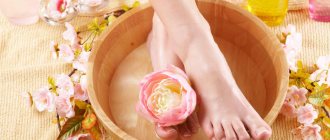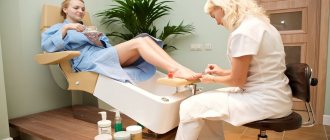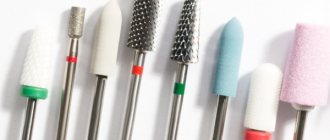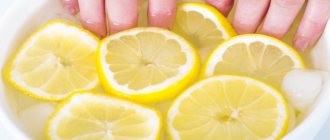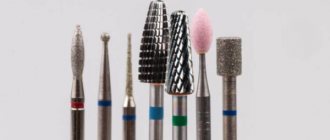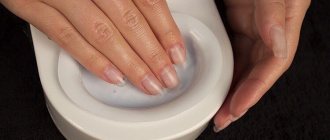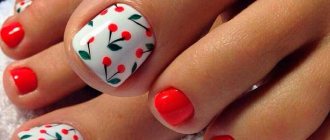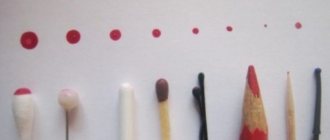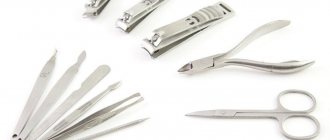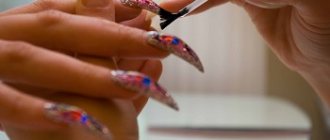Every woman wants to be happy and feel perfect in any situation. To do this, you need to take care of your health and care for your body every day. We must not forget about the feet: systematically performing a pedicure helps relieve fatigue and create an easy gait. Moreover, the procedure is available both at home and in specialized offices.
Pedicure is a set of practical measures for caring for nails and skin of the feet, including:
- removal of calluses, corns, keratinized skin;
- cleaning the nail plate;
- treatment of cracked heels;
- filing nails, giving them a beautiful shape;
- cuticle removal;
- correction of ingrown nails;
- lengthening of the nail bed;
- applying coating to nails;
- treatment of the soles of the feet using peeling, masks, baths;
- application of moisturizers and emollients;
- acupressure foot massage.
This type of care not only gives toenails a neat, aesthetic appearance, but also prevents the development of skin diseases and foot deformities. It needs to be done less often than a manicure - once every 2-3 months is enough.
Structure of toenails
The nail is located at the tip of the outer side of the finger, representing a shiny elastic plate of keratinized epidermis. It prevents damage to the finger from mechanical impact, thereby performing a protective function. The nail is a non-living tissue; it does not have nerve endings or blood vessels, which allows it to be removed painlessly.
The structure of the nail looks like this:
- The matrix is the basis for the formation of the plate, its “soil”. How thick and wide the nail will be, and how quickly it will grow, depends on the matrix.
- The nail bed is a layer of connective tissue covered with blood vessels on which the nail is formed. Due to the nerve endings, damage to the bed is very painful.
- The nail plate is the visible outer part of the nail.
- The cuticle is a skin roll that fits tightly to the base of the plate, protecting the matrix from dirt, dust, and harmful bacteria.
Toenails grow on average 3 times slower than fingernails. The nail plate is completely replaced with a new one in 4.5 months.
How to choose quality tools
The abundance that reigns in cosmetic stores today has one significant drawback: it can be difficult for a beginner to understand it. How to choose the highest quality and most convenient tools from a variety of tools and not make a mistake?
- Don't save money. It’s not for nothing that people say “a cheap fish is a filthy fish”! Choose tweezers and scissors made from high-strength medical steel: it may cost you more, but it will serve you faithfully for many years without rusting or becoming dull.
- Look for a hand-sharpened tool. A mechanical processing method will never make the cutting surface so perfectly sharp, but it is the sharpness that often determines the quality of the future pedicure.
- Don’t be lazy to “try on” the chosen item for yourself. Check how it fits in your hand, whether it is comfortable to use, whether the spring in the tweezers moves too tightly and whether the attachment is loose in the machine.
Of course, the best option would be to buy professional tools - in every sense, they are “tailored” specifically to the needs of pedicure. For example, toenail clippers typically have thicker blades than those designed for the hands, and the tool for trimming the side ridges of the skin is slightly curved for greater comfort. But it makes no sense for beginners to buy a complete professional set; the tools already listed will be enough for them.
How to cut your toenails correctly
The toenails are quite thick, the skin on the plate is “pulled” tightly, so in order to trim them without negative consequences, you need to follow the algorithm:
- Prepare supplies in advance: nail scissors or clippers, nail file, towel, soap, bath with warm water. All instruments must be clean and disinfected.
- Place your feet in a container with water and dissolved soap and let them steam for 5-10 minutes (depending on the condition of the skin).
- Dry your feet with a towel.
- Trim the plates in an even line from edge to edge, without rounding the sides, otherwise the likelihood of ingrown nails increases. You cannot cut at the root; you need to leave an edge of about 1 mm.
- Trim the edges of the plate with a file and, if desired, treat your feet with moisturizer.
Execution technology
Depending on the method, not only the presence of certain procedures, but also the sequence of steps also differs. For a general idea, you can consider the technique of performing a combined type of pedicure:
- Make a steaming bath and take for 10 minutes. When finished, pat your feet dry with a towel.
- Apply disinfectant solution to your feet.
- Distribute the remover onto problem areas with corns and cracks, and place napkins on top of the product. Wrap your feet in film and leave for 6-10 minutes. Remove the film and remove any remaining remover with a napkin.
- Perform a hardware treatment of the feet using a sanding attachment of medium abrasiveness. After removing calluses and rough spots, take a soft bit and buff the leather until smooth.
- Next, proceed to a classic pedicure. Remove the nail polish and remove the required length using pliers, scissors and a file. Treat the cuticle by moving it or removing it using tweezers. Polish the surface of the nail plate with a soft buff.
- If necessary, degrease your nails and apply a clear base or antifungal agent. After this, you can cover the nail plates with your favorite varnish.
Step-by-step pedicure procedure
Classic pedicure
One of the most popular ways to take care of the health and beauty of your feet is a classic pedicure, also called a trim pedicure. It does not require the use of a special set of tools and is always done after thoroughly steaming the legs.
How to do a classic pedicure:
- feet are immersed in a bath of warm water, in which soap or salt have previously been dissolved (if there are no problems with the skin condition), citric acid (if the plates require whitening), salicylic acid (for more intense softening), herbal decoctions (to soothe the skin and speed up healing wounds and scratches);
- using a scraper, pumice stone, or a special file for grinding varying degrees of hardness, keratinized skin and corns are removed;
- The cuticles are cut using nippers, and the plates are given the desired shape.
Advantages of a classic pedicure:
- the price is lower than other varieties;
- the service is provided in any pedicure salon;
- Can be done at home;
- instant tidying up of the nail bed;
- Removing keratinization after steaming allows you to achieve the softest effect.
Disadvantages of classic pedicure:
- high probability of skin damage;
- the possibility of infection from a cut;
- short-term results, since after softening the cuticles and corns, regeneration processes are activated, forcing the cut areas to quickly recover;
- the master can cut off the excess, after which it will hurt to step on your foot.
Medical pedicure
This type of foot care is performed only by professional podiatrists who have undergone special training. The procedure is done after consultation with a doctor who has identified a dermatological or surgical problem: fungus, increased sweating, ingrown nails, warts, etc.
The essence of the procedure is that, using modern devices for removing dead skin, the doctor relieves the patient of the disease and puts his nails in order. The skin of the feet is softened with special lotions and creams; steam baths are not used. Depending on the lesion, not only the cuticle, but also the nail plate can be removed.
Step-by-step instructions:
- Foot treatment. Before starting the procedure, the doctor disinfects the feet with an antiseptic. This prevents the penetration of bacteria and also helps fight fungus.
- Softening by applying special products to the entire surface of the foot.
- Hardware removal of dead skin. The doctor selects the right attachment, removes dead cells, treating each finger and problem areas.
- Working on the nail plate. The podiatrist polishes the nails, processes the cuticles with a device, and, if necessary, shapes the nail bed with a file and other devices. Some diseases require partial or complete removal of the plate, which is then replaced by a temporary prosthesis.
- Applying masks and creams. To consolidate the result, the legs after the procedure are cleaned of epithelial remnants and covered with restorative agents. Sometimes antifungal varnish is applied to the nail plates.
Read more in the article: “Medical pedicure: indications and features”
How much does a pedicure cost?
The price of a pedicure varies from 1,000 to 4,000 rubles depending on the type of service. In addition, the region in which you are located plays an important role. A pedicure will cost you the most in Moscow and St. Petersburg, and in other regions it is a couple of thousand rubles lower.
The most expensive is a medical pedicure, while the European one is cheaper.
If you want to learn how to do a pedicure yourself and not depend on a manicurist's schedule, sign up for a manicure and pedicure course.
During the courses you will be taught how to perform different types of pedicure, as well as how to massage your feet and how to use tools correctly. Classes are suitable for both beginners and those who want to improve their skills and acquire useful skills.
Please note that the courses include not only theory, but also practice. There you will practice your acquired knowledge on models.
On average, the course takes 5 lessons of 3-5 hours and costs from 7,000 to 20,000 rubles.
We hope that pedicure did not seem like a complicated procedure to you. Be patient and experiment. If you still weren’t able to learn on your own, be sure to sign up for a pedicure course and master all types of this procedure.
This training may be right for you:
- Best Online Manicure Courses from 1,000 Rubles
- 10 Best Manicure Training Courses in Moscow
- 10 Best Manicure and Pedicure Courses in St. Petersburg
- Best Nail Extension Courses in Moscow from 1,000 Rubles
- 10 Pedicure Training Courses in St. Petersburg
- 10 Best Nail Extension Courses in St. Petersburg
Choose the Best Courses in Your City: Yekaterinburg , Krasnodar , Nizhny Novgorod , Novosibirsk , Rostov-on-Don , Perm , Krasnoyarsk , Voronezh , Omsk .
Hardware pedicure
A pedicure done with the device allows you to consolidate the results for a long time. It belongs to the “dry” types of foot treatment, as it does not require preliminary steaming. The procedure is performed with a machine with a large number of attachments, cutters and caps. The master himself selects the right tool, based on the condition of the legs.
The essence of the procedure is to use a device with a nozzle rotating at a speed of up to 50 thousand revolutions per minute to painlessly rid the feet of rough skin. Cuticles are processed according to the same principle without previous softening.
Advantages of hardware pedicure:
- injuries and cuts are minimized;
- speed of implementation;
- elimination of problems that are not possible with the classical procedure;
- lasting effect up to 4 weeks.
Disadvantages of hardware pedicure:
- if the treatment is performed by an incompetent specialist, he can cause serious harm to the skin;
- relatively high price;
- an unpleasant burning sensation in people with sensitive skin and thin nail plates.
Read more in the article: “Hardware pedicure: how it’s done, pros and cons.”
Types of pedicure
To understand more fully about the process of foot care itself, you need to consider the distinctive features of each type of treatment. There are several main types of pedicure, each of which is recommended depending on the condition of the feet and personal preference.
The result of the pedicure procedure
Classical
The standard foot care method is a trim pedicure, also called a variation of the classic look. This procedure requires the usual set of tools, including scissors, nippers, files, buffs, scrapers, and pumice stones.
A classic trimmed pedicure is performed after taking a steaming bath, to which soap suds, salt, herbal decoctions, citric or salicylic acid and other ingredients of your choice are added. Using tools, keratinized areas of skin, calluses, corns, and cuticles are removed. As in a classic manicure, the toenails are trimmed and shaped into the desired shape, after which the surface is sanded and polished.
Advantages of the trimming method:
- relatively low price;
- can be done in any regular salon or at home;
- quick effect;
- Steaming makes it easy to remove unevenness.
Disadvantages of the classical method:
- high risk of skin damage and wounds;
- there is a chance of introducing microbes;
- short term result.
Performing a trim pedicure
European
A gentle way to care for your feet can be called a European or unedged pedicure. The entire procedure is based on a properly selected cosmetic product containing solvents. Typically, this is a gel or cream that is applied to the foot and left for about 10 minutes. After the skin has softened, the cuticle is moved and the feet are treated with a sander.
Advantages of the unedged method:
- speed of the procedure;
- safety from damage;
- Only dead epithelium is removed without affecting the functioning skin.
Disadvantages of the European method:
- short-term effect;
- the skin after the procedure is not as smooth as after the instrumental method;
- You may get a low-quality product that causes skin irritation or nail fungus.
Application of product for unedged pedicure
Hardware
A technique that does not require preliminary steaming and softening is called “dry” or hardware pedicure. The processing is carried out with a special machine with attachments of various hardnesses and shapes. For each stage and area of the foot, its own cap is selected and certain speeds are set.
Advantages of performing the hardware method:
- no risk of injury;
- long lasting effect;
- fast processing;
- eliminating more problems than other methods.
Disadvantages of the hardware method:
- training and skill are required so as not to harm the skin;
- relatively high cost;
- some discomfort for those with sensitive skin.
Hardware pedicure procedure
Medical
In case of obvious problems with the health of the feet, it is necessary to consult a doctor who can prescribe a medical pedicure. It is performed only by qualified physicians. Specialists use special creams and tools to eliminate foot fungus, hyperhidrosis, warts, ingrown toenails, and nail fungus. This procedure is sometimes called an acid pedicure, as it involves the use of chemical acids and other substances.
Advantages of the treatment method:
- getting rid of fungus and infections;
- prevention of foot diseases;
- regulation of excessive sweating;
- high efficiency.
Disadvantages of medical pedicure:
- in case of severe damage, the nail plates can be removed;
- it is possible that several procedures will be needed;
- risk of skin irritation from potent drugs.
Treatment of nails during therapeutic pedicure
Japanese
An unusual and one of the most pleasant ways to care for your feet is a Japanese pedicure. This method includes treating the skin with scrubs, applying natural plant extracts to the feet, foot massage, and waxing the nails.
Advantages of Japanese pedicure:
- does not damage the skin;
- Relaxation of the legs and whole body is achieved;
- painlessness;
- can be done at home using special socks with softening ingredients.
Disadvantages of the Japanese method:
- high price;
- The service is rarely found in salons.
Japanese pedicure - applying a scrub and putting on socks
SPA
Complex treatment of feet using various cosmetics is called SPA pedicure. As a rule, it is accompanied by aromatherapy, massage and music for relaxation. Often such a pedicure is carried out with other procedures performed in parallel: facials, manicures, body massages, etc. It is important that during all manipulations no mechanical instruments are used.
Advantages of SPA pedicure:
- rest of the whole body;
- good long lasting effect;
- there is no risk of injuring the skin.
Disadvantages of the method:
- high prices;
- Not suitable for severe compactions and deep calluses.
Massage during SPA pedicure
Combined
In order to take into account all individual characteristics and choose the most comfortable care option, a combined pedicure is performed. It usually consists of hardware and trimming method. Finally, the procedure may be accompanied by applying cream or oil to the skin and massaging the feet.
As a result of a combined pedicure, a long-lasting effect of perfectly smooth feet is achieved. In addition, a more accelerated recovery of the epithelium is noticed after eliminating large corns and cracks.
Combined pedicure - hardware plus classic
European pedicure
Foot care according to the European method involves the use of the latest achievements in the field of cosmetology. The cuticles are treated with a composition that dissolves them within 10-15 minutes. Subsequently, they will no longer be so hard; the product helps soften them for a long period of time.
The essence of the procedure is that the master applies a special gel to the cuticles and corns to soften them. He then uses an orange pusher to push back the skin, revealing the nail bed. To process the feet, graters and grinders are used.
Advantages of European pedicure:
- speed of execution, since steaming is not necessary;
- maximum skin safety;
- Only the roughened epithelium is removed, the “living” skin remains intact.
Disadvantages of European pedicure:
- the use of low-quality cosmetics can lead to nail diseases;
- the effect does not last long, the cuticle quickly loses its well-groomed appearance;
- the soles of the feet are not as soft and smooth as after a classic pedicure.
Recommendations for creating
Yes, there are no clear requirements for the colors and design of nails for spring, but there are generally accepted, traditional options - we’ll talk about them.
- light shades . White, beige, pastel and nude tones symbolize lightness and freshness, so this is what you need for spring design;
- Blue-violet, lilac. Blue-violet, as the color of the year 2022, is relevant at any time of the year, including spring. It calms, pacifies, and is also suitable for women of any age and social status;
- colors of nature . Spring is the time when nature wakes up after winter sleep, so natural shades will be more relevant than ever. Pay attention to all shades of green, yellow, brown - with them you can create a spring pedicure even without additional design;
- lactic. Let us separately highlight milky gel polishes, which came into fashion at the end of 2022.
They will look harmonious with the colors listed above.:
- rhinestones. Stones are a familiar and almost universal move. You can highlight one nail, scatter it randomly or lay out a pattern;
- sparkles. Always appropriate and in any quantity;
- drawings. Flowers, ladybugs, and animal prints are chosen as designs for spring pedicure. In general, everything related to nature. Fans of complex designs can create an abstract pattern - this is also an excellent option for nail design in the spring.
Japanese pedicure
The Japanese way of caring for the skin of the feet is to use a variety of natural-based products at each stage of the procedure. Its essence can be seen in the following stages:
- Antiseptic treatment.
- Applying scrub, rubbing with pumice.
- Apply cucumber extract to the cuticles and massage each finger.
- Polishing the nail plate.
- Rubbing the vitamin solution into the nail.
- Treat each nail with wax and paraffin.
- Covering the skin of the fingers with scented oil.
- Massage the entire foot with a special silk bag with salt and herbs.
Advantages of Japanese pedicure:
- painless;
- the possibility of damaging the skin is minimized;
- The whole body relaxes, not just the feet.
Cons of Japanese pedicure:
- there are few craftsmen who master this technique;
- high price.
At home, Japanese pedicure socks, which are plastic bags filled with a treatment agent, are popular. They are easy to use: just put them on clean, dry feet and leave them on for about 1-2 hours. Then they need to be removed and the feet should be washed thoroughly. The effect becomes noticeable a week after the procedure.
SPA pedicure
A spa treatment involves relaxation of the whole body. Scented candles, incense, relaxing music - everything contributes to complete relaxation.
The essence of this pedicure is that dead cells are removed with soft scrubs, lotions, creams, and gels. Mechanical tools are not used. The applied products take a long time to be absorbed, you need to wait until they begin to act. After the SPA, masks with sea minerals are always applied to the feet.
Pros of SPA pedicure:
- the whole body relaxes;
- the risks of injuring the skin and causing infection are minimized;
- lasting effect.
Disadvantages of SPA pedicure:
- high price;
- the skin of the feet is rougher than after a trim pedicure.
Pedicure at home
At home, it is recommended to perform only classic trimming care, for which you will need:
- container for steaming legs;
- pedicure set with scissors, nippers, tongs, pusher, etc.;
- devices for treating feet (pumice stone, grater, etc.);
- nailfile;
- moisturizing cream;
- towel.
How to do a home pedicure
The procedure for performing a home pedicure consists of the following steps:
- Immerse your feet in a bath of warm water for 10-15 minutes.
- Dry your feet and use tweezers or scissors to shorten your nails.
- Use a pumice stone or a grater to remove keratinized epithelium on the feet, paying special attention to the heels and the skin between the toes.
- Trim the cuticle with nippers, using repeated gentle movements to move the remaining skin with a wooden spatula, opening the nail plate.
- File your nails and give them the desired shape (square will help avoid ingrown nails).
- Apply moisturizer.
- If desired, varnish.
Calluses and cracks
A large load on the feet, combined with improper care, leads to the formation of calluses, corns and cracks of varying depths on the feet. With minor manifestations, such problems can be dealt with at home. To do this, you need to take evening baths every day, adding restorative solutions to the water.
If the thickness of the dead epithelium is so great that pain appears when walking, then you cannot do without a visit to the pedicure salon. The specialist will assess the extent of the damage and suggest appropriate treatment.
Procedures supporting pedicure
After a visit to the salon or home care, you need to carry out maintenance procedures to maintain the effect. At least twice a week, feet should be moisturized with creams based on soothing herbs. Scrubs designed specifically for feet and containing apricot, almond, etc. kernels will be useful. Peeling with their help should also be done at least 2 times a week.
A good way to prevent keratinization of the skin of the feet is to wear comfortable shoes made of high-quality materials that prevent excessive sweating.
Pedicure tools
The procedure includes caring for the nails and skin of the feet, so to perform it you will need not only a pedicure kit, but also equipment for treating the feet.
Rules for choosing a tool
When choosing tools for a home pedicure, you need to pay attention to:
- material - metal objects must be made of stainless steel; if it is a file, then, on the contrary, it should not be made of metal;
- quality - you need to check the manufacturer: read reviews about it, study the official website;
- size – items should be compact and easy to use;
- sharpening - only sharp tools will help achieve the desired effect;
Varieties of basic pedicure tools
There is no strict classification of items for pedicure, but they are usually divided based on the purpose of use:
- to tidy up the nail plate;
- for processing cuticles;
- to remove roughened epithelium and polish the foot;
- to eliminate problems such as fungus, ingrown toenails, calluses, etc.
The main tools for foot care are:
- scissors - preferably with straight ends, since you need to cut in a straight line;
- nippers - used both for shortening the nail and for cutting cuticles;
- tongs – cut thick nails;
- files – different types are required: coarse-grained, grinders, buffs, polishers, etc.;
- pusher - helps to push back the cuticle;
- scraper – removes dead skin from the heels;
- pumice and graters also remove keratinized epithelium.
Pedicure is an important procedure that performs both aesthetic and therapeutic functions. If you have calluses, corns, ingrown toenails or foot problems, it is better to consult a specialist.
Pedicure is beauty
Probably the very first thing a client expects from a pedicurist is beautiful nails, smooth pink heels, skin on the feet without calluses or thickening. Not only women should have well-groomed feet; many men are also happy to resort to the services of a pedicurist. Of course, there is a difference in men's pedicure: nails are not covered with decorative varnish; a colorless protective coating is allowed.
For clients who complain about the unattractive shape of their nails and unevenness, the masters offer extensions - the artificial coating reliably masks acquired and congenital defects, making the nail plate an ideal base for applying varnish.
For women, when creating a nail design, the same unlimited possibilities open up as in manicure: the varnish coating can be plain, French, with various patterns, with rhinestones, metal decor. In summer and spring, bright, saturated colors are chosen, in autumn and winter, calmer tones are chosen. Modern fashion does not adhere to strict rules in choosing the color of varnish for a pedicure; you can choose the same tone with a manicure or with clothes, you can use contrasting combinations. The main thing is that your nails look neat; it would not be embarrassing to wear open shoes.
